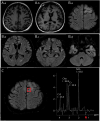Clinical Reasoning: A 17-Year-Old Girl With Progressive Cognitive Impairment
- PMID: 37491326
- PMCID: PMC10573138
- DOI: 10.1212/WNL.0000000000207597
Clinical Reasoning: A 17-Year-Old Girl With Progressive Cognitive Impairment
Abstract
A 17-year-old girl presented with a long history of cognitive impairment, personality and behavioral changes, dysarthria, and paroxysmal lower-extremity weakness. She was initially suspected of having mitochondrial encephalomyopathy with lactic acidosis and stroke-like episodes because of stroke-like symptoms, such as episodic lower-extremity weakness, as well as abnormal brain MRI findings of generalized cerebral atrophy, extensive high-intensity lesions in the cortex and subcortical white matter on fluid-attenuated inversion recovery images, decreased N-acetyl aspartate/creatine ratio, and a lactate peak in the focal area on spectrum images. However, there were no relatives with similar presentations in the family of the patient. The whole mitochondrial genome and whole-exome sequencing did not suggest pathogenic mutations, and no abnormalities were found in the blood or CSF lactate levels. In this case, we detail the clinical manifestations, diagnostic workup, and imaging findings. This case highlights the importance of assessing cognitive function and the relevant differential diagnoses in an adolescent with cognitive impairment.
© 2023 American Academy of Neurology.
Conflict of interest statement
The authors report no relevant disclosures. Go to
Figures

Similar articles
-
[Clinical, pathological and molecular biological characteristics of mitochondrial encephalomyopathy with lactic acidosis and stroke-like episode in children].Zhonghua Er Ke Za Zhi. 2013 Feb;51(2):130-5. Zhonghua Er Ke Za Zhi. 2013. PMID: 23527980 Chinese.
-
Evolution of brain imaging abnormalities in mitochondrial encephalomyopathy with lactic acidosis and stroke-like episodes.J Neuroophthalmol. 2006 Dec;26(4):251-6. doi: 10.1097/01.wno.0000249317.81367.3d. J Neuroophthalmol. 2006. PMID: 17204916
-
[MELAS: Mitochondrial Encephalomyopathy, Lactic Acidosis and Stroke-Like Episodes].Brain Nerve. 2017 Feb;69(2):111-117. doi: 10.11477/mf.1416200650. Brain Nerve. 2017. PMID: 28202819 Review. Japanese.
-
Diffuse posterior leukoencephalopathy in MELAS without stroke-like episodes: A case report.Medicine (Baltimore). 2023 May 5;102(18):e33725. doi: 10.1097/MD.0000000000033725. Medicine (Baltimore). 2023. PMID: 37144988 Free PMC article.
-
Mitochondrial encephalomyopathy with lactic acidosis and stroke (MELAS).Rev Neurol Dis. 2005 Winter;2(1):30-4. Rev Neurol Dis. 2005. PMID: 16400302 Review.
References
Publication types
MeSH terms
LinkOut - more resources
Full Text Sources
Medical
